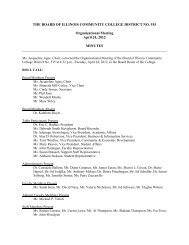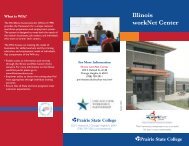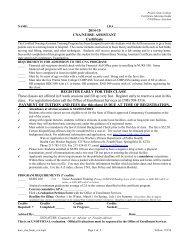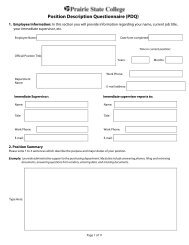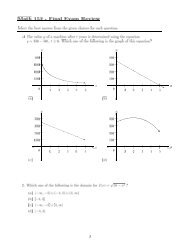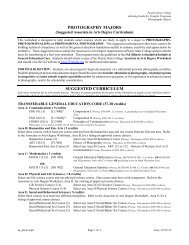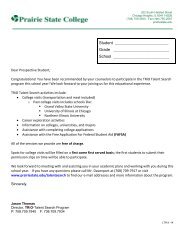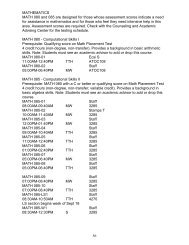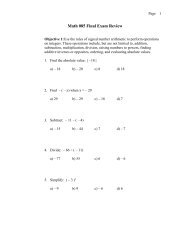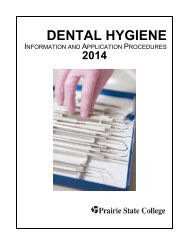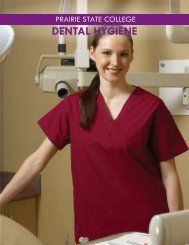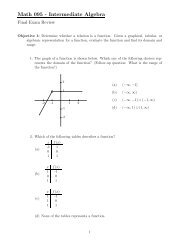catalog - Prairie State College
catalog - Prairie State College
catalog - Prairie State College
- No tags were found...
Create successful ePaper yourself
Turn your PDF publications into a flip-book with our unique Google optimized e-Paper software.
2006-2008 CATALOGCOMPUTER SCIENCEA.S. Degree • Suggested CurriculumINFORMATION SYSTEMS EMPHASISThe study of computer science and business focuses on thedevelopment of problem-solving skills and tools, and the abilityto analyze situations and effectively use these tools. Careeropportunities exist for business and financial analysts and informationsystems specialists. Students are strongly encouragedto complete the Associate in Science degree prior to transfer.I. GENERAL EDUCATION CORE (38-40)Area A: Communication (9 credits)ENG 101 [C1 900] Composition I - with a grade of C or better (3)ENG 102 [C1 901R] Composition II - with a grade of C or better (3)COMM 101 [C2 900] Principles of Communication (3)Area B: Humanities and Fine Arts (9 credits)Select three courses from the list for Area B on pages 42-44, with atleast one course from humanities and one course from fine arts.Area C: Mathematics (4-5 credits)Select one math course from:MATH 155 [M1 906] Finite Mathematics (4)MATH 157 [M1 900-B] Calculus for Business and Social Sciences (4)MATH 171* [M1 900-1] Calculus with Analytic Geometry I (5)Area D: Physical and Life Sciences (7-8 credits)Select one life science course and one physical science course from thefrom the list for Area D on pages 42-44. One course must have a labcomponent.PHYSI 210 [P2 900L] University Physics I (4) recommendedLife Science Course (3-4)Area E: Social and Behavioral Sciences (9 credits)Select three courses in at least two different disciplines from the list forArea E on pages 42-44 including:ECON 201 [S3 901] Macroeconomic Principles (3)ECON 202 [S3 902] Microeconomic Principles (3)Select one course other than ECON (3)II.AREA OF CONCENTRATION/MAJOR FIELD (9)ITAPP 101 [CS 910] Introduction to Computers (3)Select one programming language sequence from the following:ITPRG 142 Introduction to Visual Basic Programming (3)and ITPRG 242 Advanced Visual Basic Programming (3)ORITPRG 144 Introduction to C++ Programing (3)and ITPRG 244 Advanced C++ Programming (3)ORITPRG 147 Introduction to JAVA Programming (3)and ITPRG 247 Advanced JAVA Programing (3)III. ELECTIVES (13-15)BUS 131 [BUS 903] Financial Accounting (4)BUS 132 [BUS 904] Managerial Accounting (3)BUS 240 [BUS 901] Elementary Statistics (4)MATH 210 [CS 915] Discrete Mathematics (3)Select additional general education courses from the list on pages42-44, or contact the planned transfer institution for additional courserecommendations.Required A.S. Degree Program Total: 62 creditsCOMPUTER SCIENCEA.S. Degree • Suggested CurriculumDEGREES, CERTIFICATES, COURSESTRANSFER DEGREESTECHNICAL EMPHASISThe Computer Science-Technical Emphasis curriculum focuseson algorithms, theoretical foundations of computer science, anddevelopment of software. A strong foundation in mathematicsand science is needed for this emphasis. Graduates of thisemphasis will be prepared to work for a variety of companiesincluding those that have a software, engineering, scientific ormathematical focus. Baccalaureate schools may have multiplecomputer degree programs, often located in different departments,which build on the recommendations for the ComputerScience:Technical Emphasis. This major is typically found in adepartment named Computer Science or Mathematics andComputer Science or within a <strong>College</strong> of Engineering. Someschools may not require all of the courses listed below.Consult the baccalaureate schools you are considering and anadvisor to select the appropriate courses for you.I. GENERAL EDUCATION CORE (39-40)Area A: Communication (9 credits)ENG 101 [C1 900] Composition I - with a grade of C or better (3)ENG 102 [C1 901R] Composition II - with a grade of C or better (3)COMM 101 [C2 900] Principles of Communication (3)Area B: Humanities and Fine Arts (9 credits)Select three courses from the list for Area B on pages 42-44, with atleast one course selected from humanities and one from fine arts.Area C: Mathematics (5 credits)MATH 171 [M1 900-1] Calculus with Analytic Geometry I* (5)Area D: Physical and Life Sciences (7-8 credits)PHYSI 210 [P2 900L] University Physics I * (4)Life Science course (3-4)Area E: Social and Behavioral Sciences (9 credits)ECON 201 [S3 901] Macroeconomic Principles (3)ECON 202 [S3 902] Microeconomic Principles (3)Social & Behavioral Science Course, other than ECON (3)II.AREA OF CONCENTRATION/MAJOR FIELD (9)MATH 172 [EGR 900-2] Calculus with Analytic Geometry II* (5)MATH 173 [EGR 900-3] Calculus with Analytic Geometry III* (5)MATH 210 [CS 915] Discrete Mathematics (3)PHYSI 220 [EGR 912] University Physics II* (4)PHYSI 230 [EGR 914] University Physics III* (4)III. ELECTIVES (13-14)Students should select electives from the general education course liston pages 42-44.Required A.S. Degree Program Total: 62 credits* Students should complete the entire calculus and physics sequences at thesame school prior to transfer, since topics are covered in different order bydifferent schools. Second and third courses in each sequence can be used aselectives.DEGREES,CERTIFICATES,COURSES* Students should complete the entire sequence of MATH 171, 172 and 173in the same school prior to transfer, since topics are covered in different orderby different schools.51



